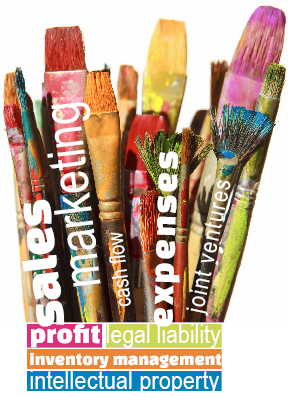Making a name in the art world used to mean the artist toiled in obscurity and poverty, dependent on galleries and patrons to exhibit and champion his work. This notion — that artistic creativity and business savvy occupy separate worlds — was reinforced by art schools that taught students how to make art but not how to market or sell it.
An emerging, 21st century approach is that art making is a business and the artist should be at the controls — the chief executive officer of her own production and distribution network. This model borrows many ideas from the business world.
Get serious about sales. Artists should tear down the contrived wall between the creative and the commercial, because distribution of artwork is just as important as production. They should school themselves in marketing, inventory and financial management, cash flow and all licensing and intellectual property laws that pertain to creative works.
Run like a business. Successful businesses keep track of revenues and expenses and pay their taxes on time. Most artists are sole proprietors and thus responsible for paying estimated income taxes, self-employment taxes and various state and local taxes. Artist-entrepreneurs who don’t want to do the paperwork should hire a bookkeeper or accountant to do it for them. Failure to pay taxes is a serious crime that can destroy a business.
Pick a legal structure. Not every artist works alone in a studio. Many share workspace or collaborate on installations and other projects. Artists working together should use a company structure that limits their individual legal liability for accidents or business debts and lowers their tax burden. An accounting professional or business lawyer can help artists understand the pros and cons of various business structures, including limited liability company, joint venture and partnership arrangements.
Be a self-promoter. Yesterday’s artists relied solely on galleries and agents to display their work, and they paid a commission for this exposure and representation. While these venues continue to be important for emerging artists, they aren’t the only marketing outlets available. Technology and social media empower artists to represent themselves and market their creations directly to the world. At a minimum, an artist needs a professional website: It’s the artist’s virtual gallery that potential customers can visit at any time to view artwork, learn more about the creator and buy art.
Use available resources. Artists looking for capital and basic business skills have many service providers to choose from in New Mexico. The state’s 20 Small Business Development Centers offer free confidential counseling on starting and sustaining a business, accounting, financing, e-commerce and many other aspects of running a profitable enterprise. Community development lenders WESST, Accion and The Loan Fund can connect artist-entrepreneurs to financing if they’re not eligible for a loan from a traditional lender, and all three nonprofits provide other services — such as consultation, mentoring and skills training — to help aspiring entrepreneurs. To stay abreast of all business and community development workshops and events around the state, the New Mexico Business Calendar (bizcalendar.org) is a quick reference.
An artist who acts like a businessperson has a greater chance of success than one who does not.
Download 374_New Model for Artists Borrows From Business PDF

